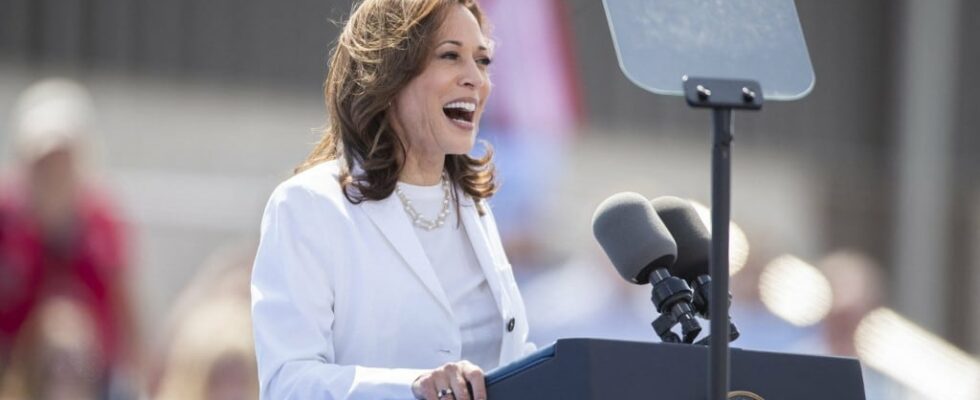She couldn’t have dreamed of more “trendy” support for her campaign launch. A few hours after taking over from Joe Biden in the race for the White House, on July 21, Kamala Harris was dubbed by British singer Charli XCX on X. “Kamala IS brat”, the pop star launched – very popular with generation Z and millennials -, in reference to the name of his latest hit album (Brat), released a month earlier. In the process, the vice president’s campaign teams changed the banner of her X account, Kamala HQ, to adorn it with the very recognizable neon green color of the album with the same font. A little over two weeks later, the image has not changed, and the popularity of the Democratic candidate among young voters is confirmed.
According to a survey Morning Consult published on August 5, Kamala Harris leads Donald Trump by 9 points among voters aged 18 to 34 (49% against 40). A record and a clear improvement on Joe Biden’s score, who, during the last measurement by the institute, was 9 points behind his Republican opponent. “The popularity of Democrats has undeniably improved among young people since she became a candidate in place of Joe Biden,” insists Marie-Christine Bonzom, a political scientist specializing in the United States and former BBC correspondent in Washington. The last weeks of Biden’s candidacy had resulted in a real hemorrhage within this category of voters, which Kamala Harris is in the process of re-aggregating behind her.”
Mobilization on the ground
The vice president quickly managed to distinguish herself from her predecessor on key issues for American youth. After a meeting with Benjamin Netanyahu on July 25, the Democratic candidate promised that she “would not remain silent” on the “tragedies” underway in the Gaza Strip, before recently meeting with activists opposed to the war in Michigan – a key state with a large population of Arab origin. “Kamala Harris is seen as more progressive than Biden on certain issues that interest young voters,” says Erik Nisbet, professor of political analysis and communication at Northwestern University in Chicago. “Her more critical rhetoric than Biden towards Israel wins her points with them – even if her policy on this issue will not be fundamentally different from that of the current president.” The Democratic candidate is also driven by her defense of the right to abortion, which she has made her main hobbyhorse.
The enthusiasm surrounding his candidacy was in any case quickly measured on the ground. The non-profit organization Next Gen America, a pro-Democratic political action committee dedicated to mobilizing young voters, indicated on July 31 that it had recorded a threefold increase in volunteer registrations after Joe Biden’s withdrawal. “Biden’s failed campaign and his advanced age had completely extinguished this electorate, which is nevertheless very important since it is they who will fuel activism in the coming weeks,” recalls Romain Huret, historian of the United States and president of the School for Advanced Studies in the Social Sciences (EHESS). This mobilization is essential because it is mainly young people who will campaign on the ground and go door to door to get the votes necessary for victory.” This is far from negligible in an election that will be played out on a knife’s edge in a handful of key states.
“Reset among young voters”
“The arrival of Kamala Harris has produced a kind of “reset” among young voters, Erik Nisbet agrees. They were hungry for someone younger, more representative, closer to their ideology, and who they did not necessarily blame for the many economic challenges they are facing at the moment.” As early as July 26, less than a week after Harris launched her candidacy, 17 progressive organizations “representing hundreds of thousands of young people,” including Voters of Tomorrow and College Democrats of America, had given her their support in a press release. “It’s all the more interesting for Democrats because these organizations are able to speak to young people in an effective way, using codes specific to their culture,” emphasizes Filippo Trevisan, professor of communication at American University in Washington. In fact, social networks quickly began to overflow with memes (texts or images often parodic and imbued with a cultural reference) of support for the Democratic candidate.
Coconut emojis, for example, are ubiquitous on platforms, in reference to one of the vice president’s statements in 2023, in which she humorously recounted a phrase her mother had repeated to her when she was growing up: “I don’t know what’s wrong with you young people. You think you just fell out of a coconut tree? You exist in the context of everything you’re living in and what came before you.” The coconut has since become a well-identified rallying point for her candidacy. “This meme campaign allows Kamala Harris to gain exposure to young voters who don’t pay attention to election news and, without it, would probably have no idea who she really is,” explains Erik Nisbet. “Memes are therefore particularly useful on platforms like Instagram, TikTok or Twitter, where young voters are.” A good way for the candidate to reach a young electorate often distant from traditional media.
Especially since it could weigh heavily in the outcome of the November vote. According to a study Tufts University, the electorate will consist of nearly 40.8 million young people from Generation Z (ages 18 to 27), including 8.3 million (ages 18 to 19) who will be voting for the first time. “Young voters were crucial in swinging some key states to Joe Biden in the 2020 presidential election,” Trevisan said. “Now the question is whether Democrats can sustain that energy through November.” If so, they would be one step closer to the White House.
.
